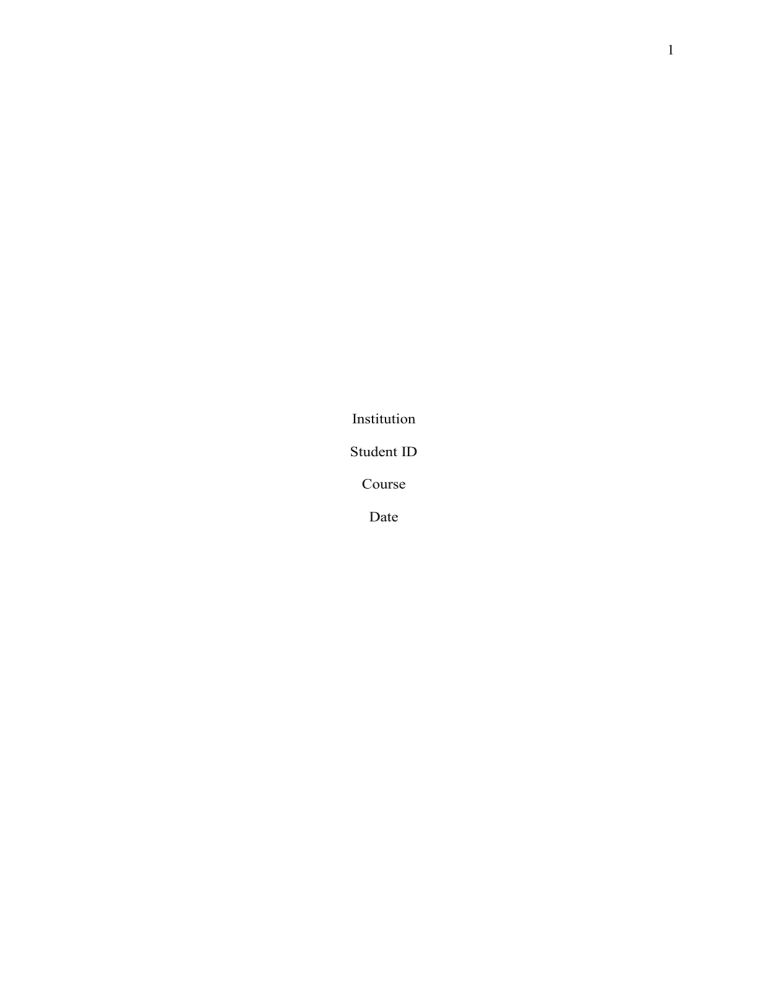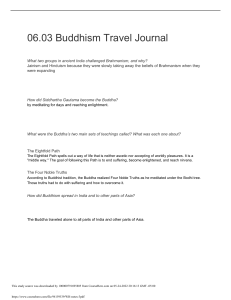
1 Institution Student ID Course Date 2 Buddhism Reflection Essay The scripture chosen for reflection is The Connected Discourses of the Buddha. Tr. By Bhikku Bodhi. It is the translation of the Samyutta Nikaya that is recognized as the third collection in the Sutta Pitaka of the Pali Canon. The Samputta Nikaya is the repository for the shorter suttas of the Buddha, in which it discloses the radical insights into the reality of nature and the unique perception of spiritual emancipation. The scripture was meant as a guide for meditators with intention to consummate their efforts based in the ultimate truth. The aim of the reflection is to examine the strengths and weaknesses of the scripture. It first summarizes the main ideas in the scripture and follow by analyzing the arguments based on Buddhism philosophy. Summary of Main Points The book comprises of 56 chapters which are government by unifying themes that connects the Buddha’s discourses. The chapters are then organized into five different parts. The first part is referred as the Book with Verses1. It mainly compiles suttas comprising mostly in verse. It is the most inspiring compilations in the canon of Buddhists is it show the Buddha is full magnificence. Primarily, Buddha is described as the teacher of gods and human who is incomparable. In this view, the scripture unleashes the true identity of Buddha as a supreme being that inspires the compilation of the Buddhist canon. The rest of the four parts of the book focuses on the philosophical principles and meditative structures depicted the Buddhism in its early years. They books are presented into short discourses that translate to major topics used in the teachings of Buddhism. The topics in the four books include dependent origination, the five aggregates, the six sense bases, the seven factors of enlightenment, the Noble Eightfold Path, and the Four Noble Truths. These topics are useful 1 Bodhi, Bhikkhu. "The connected discourses of the Buddha." (2000): 2080. http://lirs.ru/lib/sutra/Connected_Discourses_of_the_Buddha(Samyutta_Nikaya).Vol.I.pdf 3 for Buddhists since they guide them where necessary to acknowledge the Buddha’s discourses. Thus, the scripture has the Book with Verses and the philosophical principal of the early Buddhism. Analysis The main focus of this section is to evaluate the strengths and weaknesses of the topics presented in the scripture. Book of Verses When comparing Buddhism with other religions, it is true that they have similar arrangement of the verses. The chapters and verses guide the readers on where to find the content. Besides, the verses produce the radical insights of Buddha just like the Bible for Christians offers radical insights of God. In this case, Buddhists used this scripture to understand spiritual emancipation that comes from the verses. It depicts the deepest dimensions of wisdom and clarifying for people how to view the world2. Unlike Christianity, the scripture does not believe in the existence of God and the divine communication with people. I think the scripture is structured to show the principles of Buddha but not to create a divine communication need between supreme beings and human beings. For instance, Christians uses the Bible to find the messages revealed by God. Buddha’s discourses seem to be focused on personal interest and not the interest of the general population. However, the Book of Verses presented in this scripture does not mention the existence of God; thus, presents supernatural entities that can overturn the natural rules3. There is no verse backing the existence of God, making the scripture to seem obsolete and self-centered on Buddha as a 2 Bodhi, Bhikkhu. "The connected discourses of the Buddha." (2000): 2080. http://lirs.ru/lib/sutra/Connected_Discourses_of_the_Buddha(Samyutta_Nikaya).Vol.I.pdf 3 Bodhi, Bhikkhu. "The connected discourses of the Buddha." (2000): 2080. http://lirs.ru/lib/sutra/Connected_Discourses_of_the_Buddha(Samyutta_Nikaya).Vol.I.pdf 4 supernatural entity not entitled to offering divine connection with human beings. Besides, it is diffident from other religions like Christianity and Hinduism worshipping one supreme being. I think the Book of Verses fails to mention their connection with Buddha through divine connection. Meditative Structures The four books apart from the Book of Verses exemplifies the practice of meditation. I consider the Buddhism religion to practice meditation better than other religions. Primarily, the scripture meditation is a method that mental culture that Buddhists use to approach life. In this case, meditation is what makes the Buddhists not to believe in the existence of God. According to the book, meditation helps to enhance spiritual development and reveal the facts about existence4. It shows the structure of meditation under the Pali suttas. I find it interesting to utilize meditation to achieve freedom and control consciousness. The concept of Buddhism medication is unique as it helps to achieve enlightenment by distinguishing consciousness control and the nature of the world. The book offers a way to connect with inner conscious while creating an understanding while embracing freedom. I have never seen meditation as a critical structure in other religions. For instance, Christianity does not encourage meditation within its principles. So, it considers the short discourses in the scripture to relate to science, which encouraged meditation to strengthen mental process. It is recognized that people who meditate can develop critical thinking even when solving real-life problems. Thus, this scripture by Bhikku Bodhi is providing philosophical principles and meditative structures that can be useful to everyone. Conclusion 4 Bodhi, Bhikkhu. "The connected discourses of the Buddha." (2000): 2080. http://lirs.ru/lib/sutra/Connected_Discourses_of_the_Buddha(Samyutta_Nikaya).Vol.I.pdf 5 Overall, The Connected Discourses of the Buddha is a scripture that provides the meditative structures and verses that show the beliefs of Buddhists. It arranges the verses similar to the Bible and allows people to meditate by describing the structure needed to achieve it. In this view, I find the scripture useful not only to the Buddhists but also to other religious practices. The meditative structures are viewed as strengths of the scripture while the idea of not believing in the existence of God seems inappropriate. So, the book is good despite the criticism from different scholars.





